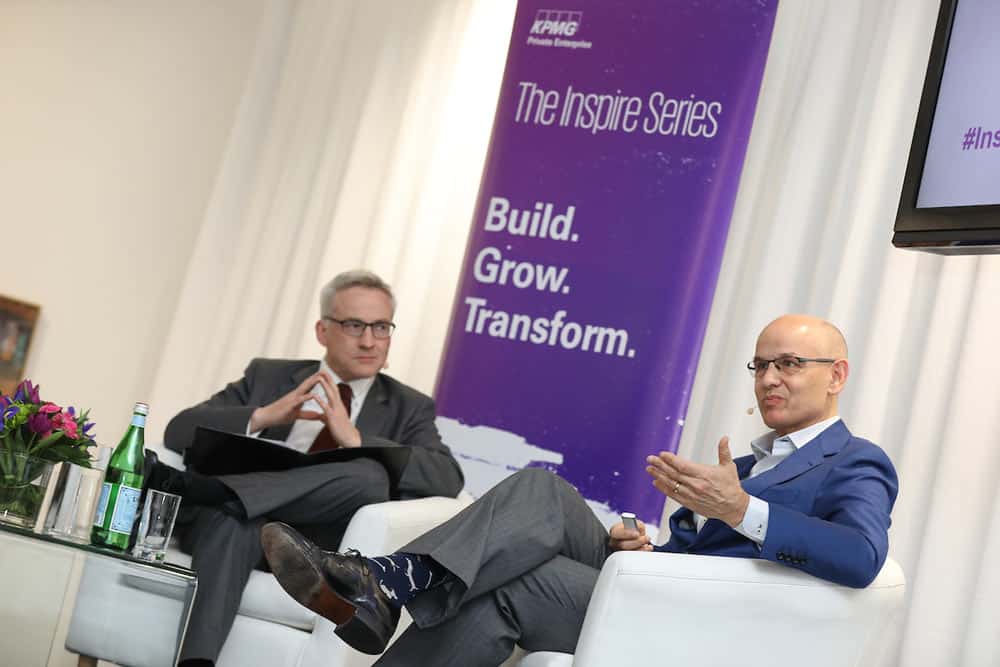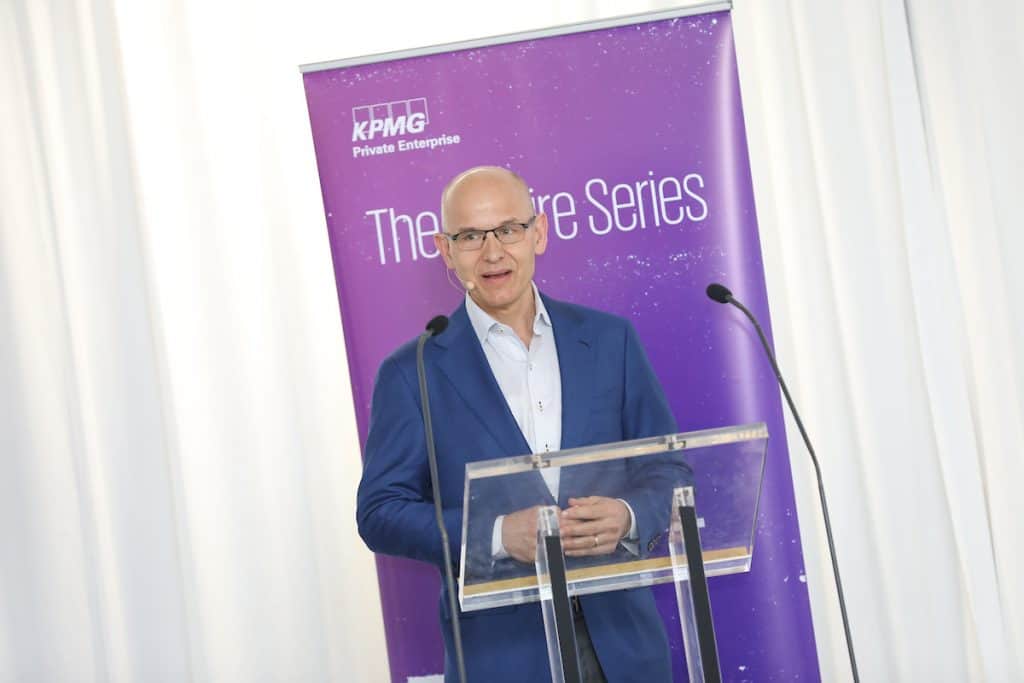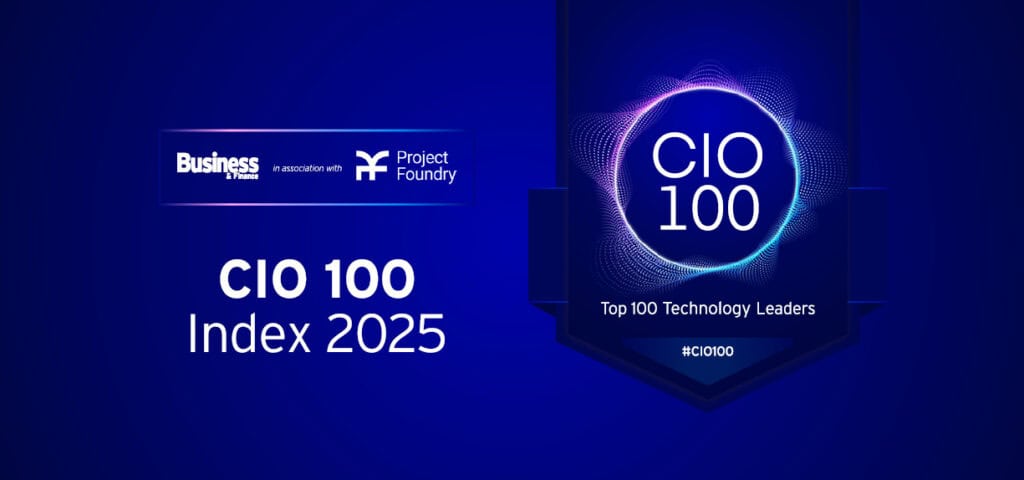Pictured: Vincent Wall (Newstalk) hosts at Q&A with David Robertson, author of “Brick by Brick” speaker at the KPMG Inspire Series event.
The latest KPMG Inspire Series lunchtime talk saw David C. Robertson, author of “Brick by Brick” explain how Lego rewrote the rules of innovation and turned their business around.
In Dublin on a rainy Wednesday lunchtime, businesspeople who braved the weather were in for a treat at the latest instalment of the KPMG Inspire Series; David C. Robertson, author of “Brick by Brick”, flew in to town to speak about his in-depth study of the business of Lego.
David C. Robertson is a professor of practice at the Wharton School at the University of Pennsylvania and was the Lego professor of innovation and technology management at IMD from 2002 to 2010. He has a unique insight into the way in which the Lego company reinvented the rules of innovation and experienced phenomenal growth, transforming itself into one of the world’s most profitable and fastest growing companies.
He told the story of how Lego has been on a rollercoaster when it came to innovation. In the late 1970s, when Kjeld Kirk Kristiansen, the grandson of Ole the founder took over the company, he unleashed a tide of innovation which launched the company on a 15-year period of 14% annual growth.
he unleashed a tide of innovation which launched the company on a 15-year period of 14% annual growth
However, this growth ground to a halt in the mid-1990s, at which point, Robertson explained, Lego fell into a trap of thinking “If one new product is good, two is better.” After tripling the amount of new product launches there was no change in sales but a big increase in costs, resulting in the first loss in company history and the layoff of 1,000 people in 1998.
Around this time other toy companies were moving production to the much-cheaper China, while Lego was produced in Denmark. It’s biggest market remained the USA, so currency issues added to the cost. Play was changing away from traditional toys, and distribution models were changing. On top of all this, Lego’s patents had run out, meaning cheaper generic versions were getting shelf space alongside the Lego products. “It’s what my colleagues in strategy call a really shitty market,” joked Robertson.

Lego threw everything they had at it, with new ideas ranging from a digital designer game, where you build on-screen with no physical bricks, to TV show which sent ultrasonic impulses to action figures which then reacted to the show.
Licensing characters from someone else’s story was a first in 1999 – and Star Wars was a new high, but also nearly bankrupted them when they got the supply wrong, not producing enough to satisfy the demand that Christmas after “Star Wars: Episode I – The Phantom Menace” had come out, then over-producing the next Christmas, when there was no new film release, and consequently less demand.
they neither innovated inside the box, nor outside the box, but instead around the box
Where Lego finally got it right, Robertson revealed, was when they neither innovated inside the box, nor outside the box, but instead around the box. “They came back to the brick, and surrounded it with complementary innovations,” he stated.
Focus groups with children were a hugely important part of this. Robertson noted, “There are only two groups of honest people in the world – kids and drunks!” The feedback from focus groups was crucial in the development of the hugely successful Ninjago line.
Robertson saw that Lego’s efforts to innovate away from their core product were unsuccessful, but when they made complementary innovations around their core product those were successful: “It’s important to keep doing whatever it is that you did yesterday that your customers are relying on you to do. How do you innovate around that to make it more useful and compelling? Try and think of innovation as dating your customer rather than fighting your competitor – get to know them, their hopes and fears, connect to them and become a bigger part of their lives.”
Try and think of innovation as dating your customer rather than fighting your competitor
He also noted that for companies wanting to innovate it’s important to put a structure around it, advising, “Give your people the freedom to explore but also the direction to deliver.” He likened it to being on dodgem cars, bouncing around ideas off each other, but inside a clearly delineated space.
In conclusion he encouraged business leaders to create a space for innovation within their companies, challenging them, “Are you even giving a forum where people can come up with ideas? And if you do, you’ll be surprised with what they will come up with.”

David Robertson is a Senior Lecturer at the MIT Sloan School of Management, where he teaches Innovation and Product Design. He’s also the host of the weekly radio show “Innovation Navigation”, a live show on SiriusXM Channel 111 where David interviews world-renowned thought leaders about the management of innovation. For more on the radio show or to download the podcast, see www.innonavi.com.
From 2002 through 2009 Dave was the LEGO Professor of Innovation and Technology Management at Switzerland’s Institute for Management Development (IMD), and from 2010 through 2017 was a Professor of Practice at the Wharton School at the University of Pennsylvania. While at IMD, David was given inside access to The LEGO Group, and wrote his award-winning book, Brick by Brick: How LEGO Rewrote the Rules of Innovation and Conquered the Global Toy Industry. Prior to IMD, David was a consultant at McKinsey & Company for 5 years and an executive at four enterprise software companies.
David’s new book, The Power of Little Ideas: A Low-Risk, High-Reward Approach to Innovation, was published in May of 2017 by Harvard Business School Press.






